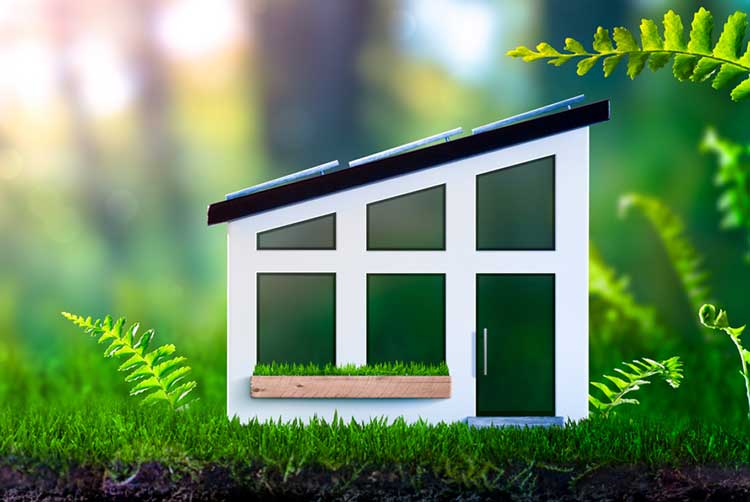Resources, Rebates, and Tax Credits to Help You Go Green at Home
Last updated November 2024

Our discussion on how to save energy at home briefly hits on more than 30 changes you can can make in and around your home, from cheap-yet-effective steps to upgrades that require upfront spending, but quickly pay for themselves from lower utility bills to systems and renovations that minimize what you pull off the grid, but come at steep prices.
Often, the extra costs of energy-saving improvements can be reduced by tax credits and utility company rebates.
Check with your utility company and EnergyStar.gov for up-to-date info on rebate programs available in your area; some are quite generous. Also check with your utility company and the Database of State Incentives for Renewables & Efficiency (DSIRE).
Federal Tax Credits and Rebates
There are two federal programs that provide incentives for home-energy-saving improvements: One provides tax credits; the other will create rebates, but the rebates aren’t yet available in this area.
Tax Credits
The “Energy Efficient Home Improvement Credit” provides tax breaks to homeowners who make green improvements to their primary residences. The credit is equal to 30 percent of the cost of eligible improvements made between 2023 and 2032. Here’s a list of eligible projects; for some there are individual annual maximum allowable credits:
- Air-sealing and insulation improvements—no cap
- Central ACs—$300 cap for most systems
- Energy audits—$150 cap
- Exterior doors—$250 per door, $500 limit for multiple doors
- Gas and oil furnaces—$600 cap for units with 97+ AFUE
- Windows and skylights—$600 cap
If you do more than one of the projects listed above there’s a maximum tax credit of $1,200 each year.
A separate tax credit of up to $2,000 is available if you buy a qualifying heat pump, biomass stove (for example, one that burns wood pellets), or boiler.
If you install a ground-source heat pump or solar panels you may qualify for a 30 percent federal tax credit with no cap. In 2033, these credits drop to 26 percent and then to 22 percent in 2034; after that, they’ll disappear unless new legislation gets passed.
Many local governments also provide incentives for residential solar-energy projects.
Rebates Coming Soon
New rebates will soon be available, funded by the federal government’s “High-Efficiency Electric Home Rebate” program. These aren’t tax credits; they’re point-of-sale rebates that homeowners will receive as discounts as they make approved improvements.
At the time of this writing, this program wasn’t yet widely available across the U.S. The law requires the Department of Energy to provide guidance to states and then each submits program proposals for review and approval; so far, only New York and Wisconsin have rebate programs up and running. Rebates for residents of most other states probably won’t be available until sometime in 2025.
Once in place, the rebates most consumers will tap into will be tied to household income. To get the full rebate amount, your household income must be less than 80 percent of the Area Median Income (AMI); if your household income is 80 percent to 150 percent of the AMI you can get 50 percent of each rebate amount; households with AMIs higher than 150 percent do not qualify for the program. You can use Fannie Mae's lookup tool to find your area’s AMI. For example, the AMI for the Minneapolis area is $123,700. That means those with household incomes of less than $98,960 will qualify for the full rebate amounts, listed below; those with incomes between $98,960 and $185,550 can qualify for 50 percent of these amounts:
- $8,000—heat pumps when installed to replace existing gas-, oil-, or propane-burning furnaces or baseboard heat as the home’s sole heating source
- $1,750—heat pump water heaters
- $840—heat pump clothes dryers
- $840—replace gas stove with electric one
- $4,000—electrical panel upgrade if needed to power any of the above improvements
- $2,500—electrical wiring upgrades if needed to power any of the above improvements
- $1,600—insulation, air sealing, and ventilation improvements
For households that make more than one of the above improvements, there is a maximum $14,000 rebate.
There will also be a separate program that provides rebates of up to $8,000 for homeowners who take steps to reduce their residence’s overall energy usage by more than 20 percent. Most states haven’t yet announced details on how they will calculate rebate amounts or whether they will impose additional income limits.
Confused by all this math? We are, too! Rewiring America built a brilliant calculator that can estimate which rebates you might qualify for.
Additional Resources to Help You Go Green at Home
Consumer Reports
Ratings of appliances, lightbulbs, window AC units, etc.
Database of State Incentives for Renewables & Efficiency
Rebates and tax incentives available from utilities and governments
Earth911.com
Green tips, plus database of recycling centers and where to dispose of hazardous household waste
Efficient Windows Collaborative
Help with window selection and estimating cost savings
Energy Star
Certifies energy-efficient appliances and HVAC equipment
National Renewable Energy Laboratory
Research and publications on renewables; offers a calculator that estimates energy production and cost of solar installations
Passive House Institute U.S.
Certification and training for net-zero energy-use builders, contractors, and manufacturers
Residential Energy Services Network
Certification for energy auditors
Rewiring America
Educational resources; tracks public policy for electrification projects; offers a nifty calculator that helps consumers figure out eligibility for rebates and other incentives
Snugg Pro
User-friendly web-based energy-auditing software
YouTube.com
Thousands of DIY videos from experts (but also non-experts)
Zero Energy Project
Advice and lists of products and suppliers for home buyers, builders, and designers interested in net-zero energy-use homes

